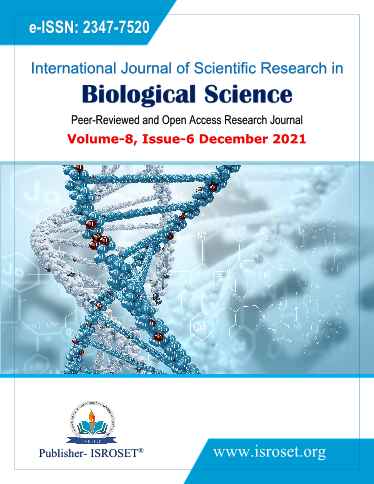Accumulation of Sulphate and Nitrate in IMLI ( Tamarindus indica L.) Tree Bark as Indicator of Atmospheric Pollution at Indore (M.P.) India
Keywords:
Tamarindus indica L., Sulphate and Nitrate accumulationAbstract
Bio-monitoring of air quality in Indore city was investigated by analyzing the accumulation of sulphate and nitrate in the bark of Tamarindus indica L. by measuring their concentration using a double beam spectrophotometer. The samples were taken from different polluted areas (mixed (MPA), vehicular (VPA), industrial (IPA), and control sites (LPA)) in different seasons. The results of the present study show sulphate and nitrate accumulation more in the rainy season at all pollution areas while maximum sulphate accumulation was found at IPA i.e. 36.9 mg kg -1 whereas it was 27.3 mg kg -1 at MPA for nitrate in the rainy season. The minimum sulphate was 16 mg kg -1 at VPA in the summer season while it was 14.8 mg kg -1 for nitrate at MPA in the winter season. A maximum % increase for sulphate was found at IPA in the summer season i.e. 88.03 % while it was 67.48 % in the rainy season at MPA for nitrate respectively. The research also confirms the suitability of the Tamarindus indica tree as a suitable bio-indicator and will help to reduce the gaseous as well as particulate pollution in the city.
References
Air Pollution Status in 51 Cities of Country, “Report – Central Environment and Forest Department and C.P.C.B., New Delhi”, 2009.
Critically Polluted Area, “Report C.P.C.B., New Delhi’, 2010.
State of the Global Air, “India Environmental Portal”, 2017.
Feder, W.A., “Cumulative effects of chronic exposure of plants to low level of air pollutants. In : Air pollution damage to vegetation”, Advance in chemistry, series No.122. Ed. J.A. Nagrere Americal Chemical Society Washington ; pp.: 21 – 30, 1973.
Staxang , B, “Acidification of bark of some deciduous trees”, Oikos ; 20 : 224 – 230,1969.
O’ Hare, G.P., “Lichen and bark acidification as indicator of air pollution in West Central Scotland”, J. Biogeogr. ; 2 : 135 –146,1974.
Grether, D. F., “The effect of high stock coal burning power – plant on the relative pH of superficial bark of hard wood trees”, Water, Air and soil pollut. ; 07, 1977.
Grodzinska, K.,” Monitoring of air pollutants by mosses and tree bark. In : Steubing L. & Jager H.-J.(eds) Monitoring of air pollutants by Plants”, Dr W.Junk Publishers, The Hague : 33-42, 1982.
Grodzinska, K., “Monitoring of air pollutants by mosses and tree bark”, In : Steubing L. & Jager H.-J.(eds) Monitoring of air pollutants by Plants. Dr W. Junk Publishers, The Hague : 33- 42,1987.
Joshi O.P., “Evaluation of air pollution damage due to Sulphur dioxide”, Ph.D. Thesis Devi Ahilya University, Indore, 1989.
Marmor, L. and Randlane, T., “Effect of road traffic on bark pH and epiphytic lichens in Tallinn”, Folia cryptog. Estonica, Fasc.; 43 : 23 – 37, 2007.
Steindor, K., Palowski, B., Góras, P., Nadgórska Socha, A., “Assessment of bark reaction of select tree species as an Indicator of acid gaseous pollution”, Polish J. of environment Stud., Vol. 20, No. 3 : 619-622, 2011. .
Trivedi, P., “Season wise comparison of Eucalyptus tereticornis Sm. and Tamarindus indica L. Bark for the accumulation of Air Pollutants at Indore City”, NAVEEN SHODH SANSAR. Seminar E- EDITION : 100-104,2020 .
Trivedi, P., “Preliminary Phytochemical Screening of Tree Bark of Tamarindus indica (L.) For Different Polluted Area At Indore City”, International Research World Journal Of Multidisciplinary Scientific Research : Vol. 8 (4) : 180 – 183,2021.
Trivedi, P., “Comparative Evaluation Of Sulphate and Nitrate Accumulation In Stem Bark of Azadirachta indica (A. Juss.) And Tamarindus indica (L.) for different Polluted Areas at Indore City (M.P.)”, The International Research Journal of Social Sciences And Humanities : Vol. 10 (4) : 27 -40, 2021.
Lippo, H., Poikolainen, J. and Kubin, E., “The use of moss, lichen and pine bark in the nationwide monitoring of atmospheric heavy metal deposition in Finland”, Water, Air and Soil Pollution ; 85 : 2241 – 2246, 1995.
El-Hasan, P. Hamzeh, A., Jiries A., Nasir F.A., “Cypress tree (Cupressus Semervirens L.) bark as an indicator for heavy metal pollution in the atmosphere of Amman city Jordan”, Environment International ; 28 : 513-519, 2002.
Berlizov, A.N., Blum, O.B., Filby, R.H., Malyuk, I.K., and Tryshyn, V.V. , “Testing applicability of black poplar (Populus nigra L.) bark to heavy metal air pollution monitoring in urban and industrial regions”, Science of the Total Environment ; 372 : 693-706, 2007.
Patterson, G.B. Jr., “Sulfur In colorimetric determination of Nonmetals”, International Science Public Inc. ; NY (New York) pp.: 216-308, 1958.
Cataldo, D. A., Harcon, M., Schrader, L. E. and Youngs, V. L., “Rapid colorimetric determination of nitrate in plant tissues by nitration of salicylic acid”. Commun. Soil Science and Plant Analysis ; 6(1) : 71-80, 1975.
Wolterbeek, H.Th., Kuik, P., Verburg, T.G., Warnelink, G.W.W. & Dobben, H., “Relations between sulphate, ammonia, nitrate, acidity and trace element concentrations in tree bark in the Netherlands”, Environ mental Monitoring and Assessment., 40: 185-201, 1996b.
Schulz, H., Popp, P, Huhn, G., Stärk, H-J. & Schüürmann, G., “Bioimonitoring of airborne inorganic and organic pollutants by means of pine tree barks”, I. Temporal and spatial variations. The Science of the Total Environment. ; 232: 49-58,1999.
Downloads
Published
How to Cite
Issue
Section
License

This work is licensed under a Creative Commons Attribution 4.0 International License.
Authors contributing to this journal agree to publish their articles under the Creative Commons Attribution 4.0 International License, allowing third parties to share their work (copy, distribute, transmit) and to adapt it, under the condition that the authors are given credit and that in the event of reuse or distribution, the terms of this license are made clear.







